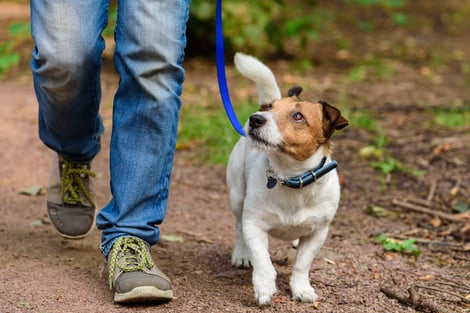Healthy, Happy Best Friends: How to Make Your Dog Live Longer

We want our best friends to live forever, but the sad reality is, they don’t.
Most of us have met a pet that defied the odds: a dog that lived much longer than expected.
In fact, Smithsonian Magazine reported in February that a Portuguese dog named Bobi broke the world record when he reached 30 years and 266 days. Bobi is an exception, of course. He has survived twice as long as the 12 to 14 years that are expected for his breed, Fafeiro do Alentejo, which guards property and livestock. Bobi’s owner, Leonel Costa, says the dog eats unseasoned human food and roams off-leash in forests and farmlands. He is cherished, but not pampered.
That’s not a realistic lifestyle for a dog in the Cleveland area, or any U.S. city. But what can we learn from dogs that live long lives?
Here are some tips on how to make your dog live longer.
Feed Them a Healthy, Balanced Diet
Most pets do best when they are eating a complete and balanced diet that meets your budget. Your vet will help you figure that out by talking to you about your pet’s age, life stage, lifestyle, body weight, and activity level.
You don’t need to spend top dollar to get high-quality pet food. In fact, veterinarians know that popular grain-free diets are unhealthy for dogs. So unless your vet determines they are allergic to grain, choose food made by a commercial pet food company that works with veterinary nutritionists.
The American Veterinary Medical Association (AVMA) recommends against giving raw or undercooked protein to your pooch, including creatures they have hunted or scavenged. The AVMA also warns that an “organic” label doesn’t necessarily mean a food is safer or more nutritious. Those words are marketing strategies. If you’ve ever taken an organic chemistry course, like veterinarians are required to take, you know that the word “organic” refers to things like plants or animals. So food is always organic.
If you are curious about what’s in your pet’s food, the Association of Animal Feed Control Officials (AAFCO) can help you understand what the ingredients list means. Look for the AAFCO statement that says the product is “formulated to meet AAFCO standards” for the life stage of your pet: puppy/kitten, adult, pregnant, lactating (female pet nursing puppies or kittens), or senior dog/cat.
Help Them Maintain a Healthy Weight
Being overweight can shorten a dog’s life. Preventive Vet says too much weight reduces life expectancy for certain breeds by almost two and a half years. Being overweight also affects your pet’s quality of life by causing inflammation, arthritis, or joint pain.
Dogs are considered overweight when they are 10% to 20% over their ideal body weight; if they are 20% or more, they are obese.
One big problem is that we don’t necessarily recognize when dogs are getting too fat. The Association for Pet Obesity Prevention estimates that more than half of dogs are overweight, but 95% of their owners thought their beloved pooches maintained a normal weight.
Dog treats are like candy for pets, and some are really not good for your dog. Human food can be high in calories and can cause your pet to gain weight. Also, many treats or people food can cause dental disease. That’s why it’s best to brush your dog’s teeth.
It takes more work, but some people like to cook food for their dogs. The website Balance It is run by a board‑certified veterinary nutritionist. The site helps you customize and create pet recipes.
Beware: Some foods and other household items are toxic to cats and dogs. Dogs should not eat anything that contains the artificial sweetener Xylitol, grapes, chocolate, onions, fatty and fried foods, macadamia nuts, or avocados.
Exercise with Them
Exercising with your pet is one of the best things you can do for their health — and yours. Did you know that living with pets improves our heart health? Fewer than 5% of adults meet the recommended weekly level of physical activity, but people with dogs are walking, on average, one hour more per week.
Walking with your dog can be a healthy and joyful activity to share. If your dog is overweight or you are not super active, consult with a veterinarian and your doctor first. You can start slow and work your way up to longer walks. Don’t forget to slow down sometimes and let your dog sniff. They experience the world through their noses. You can let them set the agenda sometimes, even if you have to readjust your idea of how fast or far you walk.
For vaccinated and well-trained dogs, a visit to the dog park helps them burn off excess energy by connecting with other well-behaved dogs. Off-leash dog parks do involve some risks, including aggressive dogs and increased exposure to parasites. Watch their body language to make sure they’re having a good time.
If you plan to visit off-leash dog parks, check out our tips for safer dog park visits. Even if you visit dog parks, it’s still important to teach your dog to walk politely on a leash. It's a great way to connect while you both get a healthy amount of exercise.
Keep Their Teeth and Gums Healthy
Healthy teeth and gums are essential to a dog’s overall health. It’s not just for better-smelling breath; tooth and gum disease can affect dogs’ kidneys, liver, and heart.
Pet parents should watch for the signs that a dog is having a dental issue: paws at their mouth, excessive drooling, their saliva contains blood, their breath smells bad, or they become a finicky eater and prefer soft foods.
Tooth brushing, veterinary-approved dental chews, and regular checkups are essential for keeping a pet healthy. Choosing the right food is also important.
Paying attention to routine dental care makes it less likely that you’ll get a surprise bill for expensive and complicated procedures to care for dental health, such as dental X-rays and extraction of diseased teeth.
Take Them to the Clinic for Preventive Care
Regular visits to the vet are important for dogs. Your vet can talk to you about how to prevent scary and expensive tickborne illnesses, parvovirus (which kills puppies), kennel cough, gum disease, and other health issues.
Veterinarians can talk to you about exercising your dog and helping them maintain a healthy weight. They can also recommend a nutritious diet to help them live longer and better.
Veterinary care can be expensive, but preventive care saves money in the long run. Pet parents in Northeast Ohio who have trouble paying for veterinary care can inquire about using Veterinary Care Vouchers provided by One Health Organization. These Vouchers help low‑income pet parents cover essential veterinary costs for their beloved pets (dogs or cats).
Don’t Delay if Your Dog Seems Sick
In addition to those regular checkups, you might need to act fast if your dog is acting out of the ordinary. Older dogs in particular should be watched for signs of lethargy, loss of appetite, vomiting, and diarrhea.
Ultimately, there are no guarantees that our pets will beat the odds, but we want to do all we can to spend as much time with these special friends as possible.

